Family name: Typhaceae A.L. Jussieu
Synonym(s): Sparganiaceae Hanin, nom. cons.
Common name(s): cat-tail family
*Number of genera/species: 2/51
List of genera records in GRIN-Global
fruit or seed
Fruit a folliclefollicle:
a dry to (rarely) fleshy fruit derived from a single carpel that opens along a single longitudinal suture, derived from a single, superior, simple ovary; the seeds may be arillate or with a fleshy testa (Typha with persistent stylestyle:
(Typha with persistent stylestyle:
in a flower, the narrow and elongated part of the pistil between the stigma and the ovary; sometimes persisting in fruit and long hairs derived from the perianthperianth:
and long hairs derived from the perianthperianth:
collective term for calyx and corolla of a flower
 ) or achenelike drupes (Sparganium), 2–7 mm long, beakedbeak:
) or achenelike drupes (Sparganium), 2–7 mm long, beakedbeak:
a usually firm, terminal appendage, sometimes tapered (persistent stylar remnantsstyle base:
(persistent stylar remnantsstyle base:
remnant of a style ), fusiformfusiform:
), fusiformfusiform:
spindle-shaped; broadest at the middle and tapering at both ends to trigonoustrigonous:
to trigonoustrigonous:
3D shape—having three faces that meet at distinct angles; triangular in outline
, tereteterete:
approximately circular in cross section; width and thickness approximately equal
 or angledangular:
or angledangular:
2D shape—having sides that meet at acute or obtuse angles
in transection, usually with one seed. In Typha, the pericarppericarp:
fruit wall or fruit coat
is transparent and splitting longitudinally in water to release minute seed. In Sparangium, the pericarppericarp:
fruit wall or fruit coat
is spongyspongy:
soft, light, discontinuous but cohesive, and somewhat resilient
to fleshy, sometimes dry, but with a bonybony:
very hard and rather brittle, like bone
endocarp, and sometimes with more than one seed. Pericarppericarp:
fruit wall or fruit coat
brown or green, shinyshiny:
uniformly reflecting a high proportion of incident light at all angles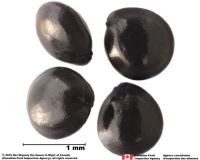 or dulldull:
or dulldull:
reflecting only a low proportion of incident light, with no apparent sheen , smooth or ridgedridged:
, smooth or ridgedridged:
surface relief—raised, thick ridges, sharp edged or rounded, usually in a series that may cover the entire surface .
.
Seeds ellipsoidellipsoid:
3D shape—elliptic
, ovoidovoid:
3D shape—ovate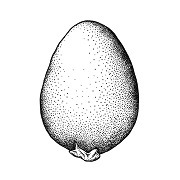 , linearlinear:
, linearlinear:
(shape) long, narrow, and uniform in width; (of embryo) embryo is straight and much longer than wide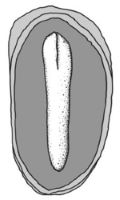 , or fusiformfusiform:
, or fusiformfusiform:
spindle-shaped; broadest at the middle and tapering at both ends , tereteterete:
, tereteterete:
approximately circular in cross section; width and thickness approximately equal
 in transection, 0.7–1.5 mm long. Seed coat brown, thin, membranousmembranous:
in transection, 0.7–1.5 mm long. Seed coat brown, thin, membranousmembranous:
texture—extremely thin, pliable, and fairly tough
, punctatepunctate:
surface relief—dotted with pits or with translucent, sunken glands or with colored dots, similar to pitted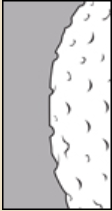 , striatestriate:
, striatestriate:
surface relief—having fine, parallel lines, grooves or ridges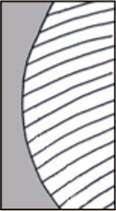 , or reticulatereticulate:
, or reticulatereticulate:
surface relief—netted, raised walls or concave grooves forming a net-like surface pattern with flat, concave, or convex interspaces . Seeds with scanty perispermperisperm:
. Seeds with scanty perispermperisperm:
seed nutritive tissue comparable to the endosperm, but derived from the nucellus (maternal tissue)
. In Sparagnium, seed coat thin but with a thickened “seed lid”.
Embryo well developed, linearlinear:
(shape) long, narrow, and uniform in width; (of embryo) embryo is straight and much longer than wide or cylindriccylindrical:
or cylindriccylindrical:
3D shape—a cylinder, with parallel sides and a circular cross-section; tubular or rod-shaped
, straight, partially filling seed coat.
Endosperm copious.
Noxious Weed: USA Federal Noxious Weed List, aquatic, Sparganium erectum L.
Federal Noxious Weed Disseminules of the US tool provides descriptions and images of this species. Aquarium & Pond Plants of the World tool also includes descriptions and images of this and other species in this family, which may be encountered.
Commonly intercepted at ports. Weedy in shallow water of lakes, ponds, rivers, channels, and swamps. Spreads by rhizome propagation or seed reproduction.
| Fruit | |
| Type | folliclefollicle: a dry to (rarely) fleshy fruit derived from a single carpel that opens along a single longitudinal suture, derived from a single, superior, simple ovary; the seeds may be arillate or with a fleshy testa  , drupedrupe: , drupedrupe:(indehiscent drupe) a fleshy, indehiscent fruit with one more hard pits enclosing seeds, derived from single, superior, simple or compound ovary; (dehiscent drupe) a fruit with a dry or fibrous to fleshy or leathery outer husk that early to tardily breaks apart (or opens), exposing one or more nutlike pits enclosing the seeds  , acheneachene: , acheneachene:a dry, indehiscent, one-seeded fruit, with seed attached to pericarp at a single point, derived from a single, superior, simple or compound, one-loculed ovary  |
| Size range | 2–7 mm long |
| Shape(s) | globoseglobose: 3D shape—more or less spherical 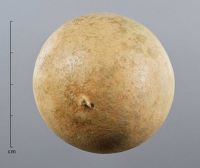 , triangulartriangular: , triangulartriangular:2D shape—three relatively straight sides with distinct corners; more angular than teardrop-shaped  , trigonoustrigonous: , trigonoustrigonous:3D shape—having three faces that meet at distinct angles; triangular in outline , fusiformfusiform: spindle-shaped; broadest at the middle and tapering at both ends  , ovoidovoid: , ovoidovoid:3D shape—ovate  , , |
| Texture | indurateindurate: texture—hardened or stony; yielding under strong pressure; not deformable without internal structural disruption , dry, spongyspongy: soft, light, discontinuous but cohesive, and somewhat resilient , fleshy, membranousmembranous: texture—extremely thin, pliable, and fairly tough |
| Surface relief | smooth, ridgedridged: surface relief—raised, thick ridges, sharp edged or rounded, usually in a series that may cover the entire surface  |
| Color(s) | brown, green |
| Unique features | One-seeded, brown or green folliclesfollicle: a dry to (rarely) fleshy fruit derived from a single carpel that opens along a single longitudinal suture, derived from a single, superior, simple ovary; the seeds may be arillate or with a fleshy testa  , drupesdrupe: , drupesdrupe:(indehiscent drupe) a fleshy, indehiscent fruit with one more hard pits enclosing seeds, derived from single, superior, simple or compound ovary; (dehiscent drupe) a fruit with a dry or fibrous to fleshy or leathery outer husk that early to tardily breaks apart (or opens), exposing one or more nutlike pits enclosing the seeds  , or achenesachene: , or achenesachene:a dry, indehiscent, one-seeded fruit, with seed attached to pericarp at a single point, derived from a single, superior, simple or compound, one-loculed ovary  with minute seeds. with minute seeds. |
| Seed | |
| Size range | 0.7–1.5 mm long |
| Shape(s) | linearlinear: (shape) long, narrow, and uniform in width; (of embryo) embryo is straight and much longer than wide  , ellipsoidellipsoid: , ellipsoidellipsoid:3D shape—elliptic , ovoidovoid: 3D shape—ovate  , fusiformfusiform: , fusiformfusiform:spindle-shaped; broadest at the middle and tapering at both ends  |
| Surface relief | punctatepunctate: surface relief—dotted with pits or with translucent, sunken glands or with colored dots, similar to pitted  , striatestriate: , striatestriate:surface relief—having fine, parallel lines, grooves or ridges  , reticulatereticulate: , reticulatereticulate:surface relief—netted, raised walls or concave grooves forming a net-like surface pattern with flat, concave, or convex interspaces  |
| Color(s) | brown |
| Unique features | Brown, punctatepunctate: surface relief—dotted with pits or with translucent, sunken glands or with colored dots, similar to pitted  , striatestriate: , striatestriate:surface relief—having fine, parallel lines, grooves or ridges  or reticulatereticulate: or reticulatereticulate:surface relief—netted, raised walls or concave grooves forming a net-like surface pattern with flat, concave, or convex interspaces  seeds with thin, membranousmembranous: seeds with thin, membranousmembranous:texture—extremely thin, pliable, and fairly tough seed coats. |
| Other | |
| Embryo | well developed, linearlinear: (shape) long, narrow, and uniform in width; (of embryo) embryo is straight and much longer than wide  or cylindriccylindrical: or cylindriccylindrical:3D shape—a cylinder, with parallel sides and a circular cross-section; tubular or rod-shaped , straight, partially filling seed coat |
| Nutritive tissue | endosperm copious |
Worldwide.
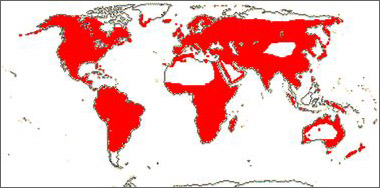
Distribution map courtesy of Angiosperm Phylogeny Website.
Baskin and Baskin 2021Baskin and Baskin 2021:
Baskin C and Baskin J. 2021. Relationship of the lateral embryo (in grasses) to other monocot embryos: A status up-grade. Seed Science Research 31 (3): 199-210. doi:10.1017/S0960258521000209; Dahlgren et al. 1985Dahlgren et al. 1985:
Dahlgren RMT, Clifford HT, and Yeo PF. 1985. The families of the monocotyledons: structure, evolution, and taxonomy. Springer-Verlag, Berlin. 520 pp.; Flora of Australia 2021+Flora of Australia 2021+:
Flora of Australia. Australian Biological Resources Study, Canberra. Accessed January 2021–March 2024. URL: http://www.ausflora.org.au; Flora of North America Editorial Committee 1993+Flora of North America Editorial Committee 1993+:
Flora of North America Editorial Committee, eds. 1993+. Flora of North America North of Mexico [Online]. 22+ vols. Flora of North America Association, New York and Oxford. Accessed January-March 2024. URL: http://beta.floranorthamerica.org.; Kirkbride et al. 2006Kirkbride et al. 2006:
Kirkbride JH, Jr, Gunn CR, and Dallwitz MJ. 2006. Family guide for fruits and seeds, vers. 1.0. Accessed September 2020-January 2022. URL: https://nt.ars-grin.gov/seedsfruits/keys/frsdfam/index.cfm .; Kubitzki et al. 1990+Kubitzki et al. 1990+:
Kubitzki K et al., eds. 1990+. The families and genera of vascular plants. 7+ vols. Berlin etc.; Le and Xu 2017Le and Xu 2017:
Le C and Xu Z. 2017. Identication and control of common weeds: Volume 3. Springer Nature, Singapore. 944 pp.; Martin and Barkley 1961Martin and Barkley 1961:
Martin AC and Barkely WD. 1961. Seed Identification Manual. Universisty of California Press, Berkeley and Los Angeles, CA, USA. 220 pp.; Napper 1971bNapper 1971b:
Napper DM. 1971b. Typhaceae. In: Milne-Redhead E and Polhill RM, eds. Flora of Tropical East Africa. Royal Botanic Gardens, Kew, Richmond UK. 5 pp.; Tutin et al. 1964–1980Tutin et al. 1964–1980:
Tutin TG, Burges NA, Chater AO, Edmondson JR, Heywood VH, Moore DM, Valentine DH, Walters SM, and Webb DA (eds.) 1964–1980. Flora Europaea. 5 vols. Cambridge University Press, Cambridge UK. 2,524 pp.; Watson and Dallwitz 1992+Watson and Dallwitz 1992+:
Watson L and Dallwitz MJ. 1992+. The families of flowering plants: descriptions, illustrations, identification, and information retrieval. Version: 6th Accessed September 2020-September 2022. URL: delta-intkey.com
*The number of genera and species is based on Christenhusz and Byng 2016Christenhusz and Byng 2016:
Christenhusz MJM and Byng JW. 2016. The number of known plant species in the world and its annual increase. Phytotaxa 261 (3): 201-217. https://doi.org/10.11646/phytotaxa.261.3.1, which may differ from the number of genera in GRIN-Global.